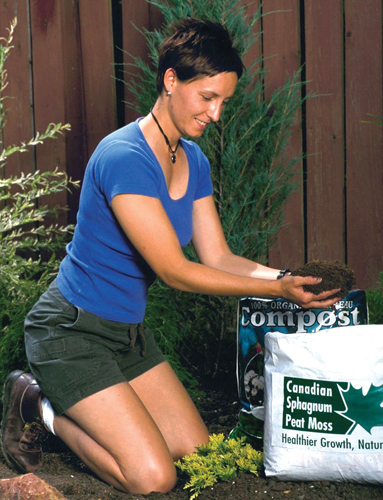Go Organic! Being Green Saves Time, Money and the Earth

|
Organic gardeners know they get a lot more benefits from their style of gardening than safe, pesticide-free flowers and produce. Organic gardeners also enjoy more green by spending less green out of their pockets.
The secret is in the soil. Organic gardening got its name from the magical benefits that happen when organic matter is added to any soil. Examples of organic matter are compost, Canadian sphagnum peat moss and shredded leaves. Whether your soil is hard-pan clay or quick-draining sand, organic matter is the great equalizer, loosening clay soil and acting like a sponge to hold moisture in sandy soils. Organic matter also encourages the billions of tiny soil critters that break down nutrients for plant life and keep soil well aerated to get busy.
Canadian sphagnum peat moss is a sustainable, ready-to-use form of organic matter that is offered in compressed bales that make it easy to use. Compost is a good organic source but few gardeners ever have enough. Savvy organic gardeners know that mixing Canadian sphagnum peat moss half and half with their compost is one way to multiply their supply of valuable organic matter. And the peat reduces compaction of the soil that is often associated with using compost by itself. For the best results, dig a 2- to 3-inch layer of your organic matter into the top 6 to 8 inches of soil.
The water-holding capacity of Canadian sphagnum peat moss and compost is another reason for gardeners to go organic. Water is a valuable resource now protected and restricted in all parts of the country, not just the dry south. The higher a soil's organic matter the lower the water bills.
Organic gardening applies to shrubs, flowers and lawns not just fruits and vegetables. Improve the soil around all your plants by adding organic matter and they'll not only need less fertilizer but with less water stress, plants will be better able to resist insects and disease. Organic gardeners accept some insect damage as a trade off for a pesticide-free garden. Eliminating pesticides from your garden is easy when healthy soil supports healthy plants.
So think the Big O when you garden and go Organic. You won't have to over-water, over-feed, or over-spend on an outstanding landscape and overly abundant garden.
To order free brochures on "How to ... with peat moss" and other gardening tips, send a self-addressed, unstamped, business-sized envelope to: Peat Moss, Box 385102, Minneapolis, MN, 55438; e-mail cspma@peatmoss.com; or visit www.peatmoss.com.
The Canadian peat industry is committed to making peat moss a sustainable resource. Only one acre in every 6,000 is harvested and when harvesting stops, the bogs are restored to functioning peatlands. For more information on peat and the environment, visit the Canadian Sphagnum Peat Moss Association's Web site at www.peatmoss.com.
Quick Tip for Working With Peat Moss:
A compressed bale of peat moss goes a long way but it often needs to be moistened before using. Warm water penetrates and moistens the peat moss faster than cold. Lay your hose out on a sunny day. Then moisten the peat with water from the sun-warmed hose.






